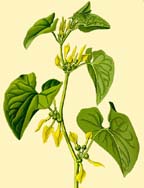|
Magickally, this plant has been used to drive out demons. It seems to have a lot of possibility for ritual work,
both in its connection to death and to snakes (Gerard describes it as an antidote
to snakebite, perhaps along the lines of fire-fights-fire). It was
in the past used against often fatal diseases, such as plague, which
reinforces the death connection, but it has also been associated
with pregnancy since ancient Thebes (interesting death/life thing
going on there). The flowers would make
an especially interesting incense for those working with Mother spirits. This magick
herb obviously has an affinity
for people, as it likes to be close to humans, growing especially in
orchards and gardens, so it must have much to teach us, despite its poisonous
nature. Top How to grow birthwort: Pre-soak the seeds for 48 hours in water hot to the touch and then sow on the soil surface. Some people cold stratify the seed for 2-3 months first in a freezer. Or sow on Winter Solstice (see the Solstice Sowing page). This seed is also a good candidate for the soaking method. It germinates in 1-3 months at 55-60F/15-20C. Transplant to pots in dappled shade. The young plants need winter protection their first year. The following spring after all danger of frost, plant in the ground in rich soil and dappled shade. This clambering plant especially likes to grow along creeks and the edges of woodlands. The flowers appear July-September. Birthwort spreads by rhizomes and can be invasive. Divide in fall if you want more plants. It is perennial to zone 6 (-10F/-23C). General growing info Top
|
Uses in Witchcraft & Magic:
Exorcism © 2004, 2014 Harold A. Roth; no reproduction of any part without permission. |
 Birthwort
(Aristolochia
clematitis) Info
Birthwort
(Aristolochia
clematitis) Info